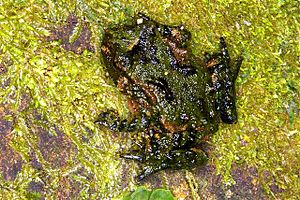Hochstetter's frog facts for kids
Quick facts for kids Hochstetter's frog |
|
|---|---|
 |
|
| Conservation status | |
| Scientific classification | |
 |
|
| Range (does not show Maungatautari) |
The Hochstetter's frog (Leiopelma hochstetteri) is a unique and ancient frog. It lives only in New Zealand. This frog is one of only four types of native frogs still found there. These frogs have some of the oldest features of any living frogs on Earth. They are sometimes called the Hochstetter's New Zealand frog.
Contents
What's in a Name?
The Hochstetter's frog got its name from a German geologist named Ferdinand von Hochstetter. This special frog is found only in New Zealand. It belongs to a very old group of frogs called Archaeobatrachia. Other frogs in this group include Archey's frog (Leiopelma archeyi), Hamilton's frog (L. hamiltoni), and the Maud Island frog (L. pakeka). Sadly, three other species from this group, L. auroraensis, L. markhami, and L. waitomoensis, are now extinct.
How to Spot a Hochstetter's Frog
Hochstetter's frogs have a skin color that can be brown-green or brown-red. They often have dark stripes and bumps, called warts, on their backs. Their bellies are usually yellow-brown. Male frogs grow to about 38 mm (1.5 inches) long. Females are a bit bigger, reaching about 50 mm (2 inches) long.
These frogs are active at night, which means they are nocturnal. During the day, they hide under rocks, logs, or other shaded places. They like moist spots near streams and wet areas in native forests. Hochstetter's frogs are carnivores, meaning they eat meat. They hunt for small creatures like spiders, beetles, and mites.
Unique Features of New Zealand Frogs
All native New Zealand frogs, known as pepeketua in Māori, share some special traits. They have muscles that can wag their tails, even though they don't have tails as adults. They also have special ribs and round eye pupils. Unlike most frogs, they don't have eardrums, eustachian tubes, or vocal sacs. This means they don't croak loudly like many other frogs.
Because they don't have good hearing, these frogs use chemical signals to communicate. They use these signals to mark their territory and recognize other frogs. Hochstetter's frogs don't make much noise, which fits with their poor hearing.
The Life Cycle of a Hochstetter's Frog
Hochstetter's frogs can live for a long time, up to 30 years! They don't start having babies until they are three years old. Each breeding season, a female frog can lay up to 20 eggs.
All four native New Zealand frog species develop as tadpoles inside their eggs. They hatch as tiny froglets with their back legs already formed. However, the Hochstetter's frog is the only one that lives partly in water. Its froglets continue to grow in water, while the other three species are cared for by their parents on land.
Where Do Hochstetter's Frogs Live?
Fossils show that all native New Zealand frogs used to live across the whole country. This changed about 200 years ago. Today, Hochstetter's frogs have the widest range of all the native frogs. They live in the upper North Island. You can find them in places like the Waitākere Ranges, the Hunua Ranges, the Coromandel Peninsula, Great Barrier Island, Maungatautari Ecological Island, and the East Coast. Scientists have found that there are ten different groups of these frogs. This is because they were separated by glaciers a long time ago.
What Threats Do They Face?
Hochstetter's frogs are facing dangers from animals that have been brought to New Zealand. These include rats, goats, and pigs. The kiore, or Polynesian rat, arrived with the Māori people. It caused many frog populations to disappear on the South Island and damaged many on the North Island over the last thousand years. Rats and stoats are known to kill Hochstetter's frogs. Other animals like pigs, cats, hedgehogs, and ferrets also likely harm them.
Animals that eat plants, like goats and pigs, can also damage the frogs' homes. They can erode the soil near streams and reduce the shade that frogs need. Changes to their habitat and its destruction are big problems. Mining can cause dirt and chemicals to wash into streams, which can poison the frogs. Logging and clearing forests can also harm stream quality.
A serious disease called chytrid fungus has caused many Archey's frogs to die. Scientists think it could also be a threat to Hochstetter's frogs.
Protecting the Hochstetter's Frog
The Hochstetter's frog is listed as "At risk–Declining" under New Zealand's own threat system. However, the IUCN considers the species to be of "Least Concern" globally. All native frogs in New Zealand are protected by the Wildlife Management Act of 1953.
In the Kokako Management Area in the northern Hunua Ranges, people have been working since 1994 to control pests. This helps create a safe home for the kokako, an endangered forest bird. Surveys of Hochstetter's frogs in this area have shown good results. The number of young frogs jumped from 10% to 30% in 2005, showing that conservation efforts can help!
See also
 In Spanish: Leiopelma hochstetteri para niños
In Spanish: Leiopelma hochstetteri para niños


